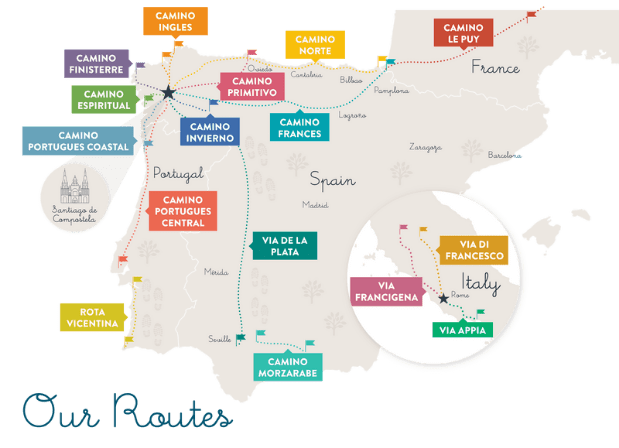The Camino de Santiago, a network of pilgrimage routes leading to the Cathedral of Santiago de Compostela in Spain, attracts thousands of pilgrims and travellers worldwide yearly. While the journey is often embarked upon for spiritual or personal reasons, staying connected during the trek is a concern for many. In this blog, we explore the availability of WiFi access along the various routes of the Camino.

WiFi Availability on the Camino
Major Towns and Cities
On the Camino, WiFi (pronounced “wee-fee” in Spanish) access is generally good in larger towns and cities. Pilgrims can expect WiFi in most hotels, hostels, cafes, and public spaces. These places often provide free WiFi to customers and guests, making it convenient to stay connected, share updates, and plan.
Rural Areas and Smaller Villages
WiFi access becomes less predictable as you venture into more rural parts of the Camino. Small villages may have limited services, with fewer accommodations and eateries offering internet access. However, some local bars and public buildings might still provide WiFi, although the connectivity could be slower and less reliable than in urban areas.
Accommodations with WiFi
Hotels and Private Hostels
Most hotels and private hostels along the Camino de Santiago have WiFi. This service is usually included in the room rate and allows guests to connect multiple devices. These establishments recognize the importance of internet access for modern travellers and typically provide good-quality connections.

Municipal Hostels or Albergues
Municipal hostels, or “albergues,” are budget-friendly options that cater primarily to pilgrims. While they are more economical, WiFi access in these facilities can vary. Some municipal hostels offer WiFi, while others do not, prioritising a more disconnected, reflective experience. It is advisable to check in advance if staying connected is essential to you.
Albergues and Desktop Computers
According to the Camino de Santiago Guidebook, the number of albergues offering desktop computers with coin-operated internet access is declining, but some still provide this service. The cost typically varies from €1 to €4 per hour. It’s important to exercise caution when entering sensitive personal information on public computers, as their security can be unreliable. Additionally, while larger cities might have internet cafes, the widespread availability of WiFi is rendering these establishments increasingly redundant.
Planning for Connectivity
Mobile Data as an Alternative
Considering the variability of WiFi on the Camino, one might consider using mobile data. Purchasing a SIM card with a data plan can be a practical solution, particularly for those requiring regular access to the internet. Coverage is generally good along the popular routes, but it’s wise to check with providers about specific coverage areas.
EU Data Roaming
You can use your mobile phone without additional charges when travelling from your home country to another country within the EU. This arrangement, often referred to as “roaming” or “roam like at home,” ensures that your phone calls (to both mobile and fixed lines), text messages (SMS), and data usage (such as internet browsing and streaming music or videos) are priced the same as they are in your home country.
This rule also extends to incoming calls and texts while you are abroad. You won’t face any extra charges for receiving calls or messages, regardless of whether the sender is on a different service provider. This makes staying connected across the EU straightforward and cost-effective. Check out Roaming: Using a mobile phone in the EU for more detailed information.
eSIMs on the Camino de Santiago
For pilgrims walking the Camino de Santiago, eSIMs represent a modern and seamless connectivity option, eliminating the need for traditional physical SIM cards. These digital SIMs can be directly downloaded to compatible smartphones, offering a variety of data plans designed to meet the needs of international travellers.
Before opting for an eSIM, please ensure your phone is eSIM-supported, as this technology requires compatibility. An eSIM allows for easy management of mobile data settings via a simple application, facilitating a consistent connection throughout different areas of the Camino. Ideal for everything from sharing photos and navigating routes to staying in touch with loved ones, eSIMs provide a flexible and user-friendly communication solution for your pilgrimage.
Check out our blog on ‘eSIMs on the Camino de Santiago‘ for more detailed information on eSIMs.
Offline Resources
For those who prefer to minimise their online presence during the pilgrimage, downloading maps and guides in advance is recommended. Many mobile applications offer offline access to valuable resources, allowing pilgrims to navigate and access information without a constant internet connection.

While the Camino de Santiago travels through some less developed areas, the availability of WiFi has significantly improved over the years, particularly in main towns and private accommodations.
Planning by checking the availability of WiFi at your planned stops and opting for a mobile data plan or an eSIM plan can help ensure that you stay connected as much or as little as you wish during your journey. Whether to share moments with loved ones or for personal safety and logistical reasons, connectivity options on the Camino are adaptable to the needs of modern pilgrims.
Contact us for more information about the Camino de Santiago routes or to book your Camino holiday. Enjoy your adventure! Buen Camino!
